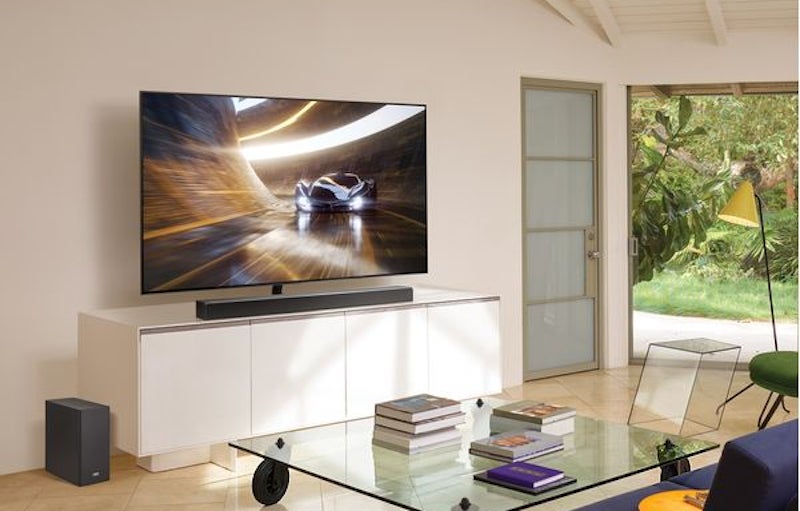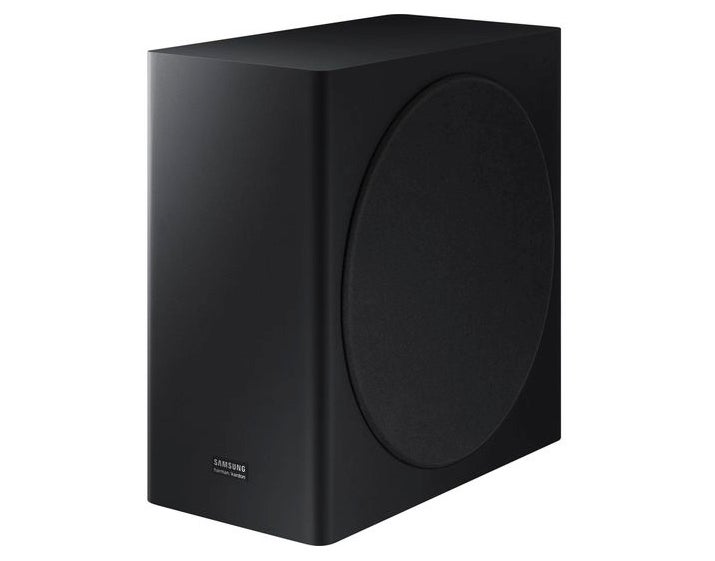What is the Samsung HW-Q80R?
The Samsung HW-Q80R (£999) is a powerful upper mid-range soundbar/subwoofer combination. It can play Dolby Atmos and DTS:X object-based audio formats, and boosts its credentials in this respect by including side- and up-firing speakers in its main soundbar.
Related: Samsung TV 2019 – Every Samsung 4K QLED TV explained
Samsung HW-Q80R design and build – A well-built piece of kit, although the subwoofer is on the chunky side
Even before you open the box you can tell the HW-Q80R is a serious bit of kit. The subwoofer and, especially, the soundbar are both weighty items, providing your aching back with plenty of proof of just how well made they are.
The subwoofer doesn’t wear its bulk particularly attractively. It’s just a chunky black lump to some extent – although at least its corners are gently rounded.
Bass lovers will be mighty pleased to clock the sub’s imposingly large (8in) side-firing driver, and the appearance on the sub’s rear of a substantial airflow port to help keep the low-frequency air flowing.

The main soundbar is a much more attractive proposition. It enjoys a lower profile than Samsung’s previous generation of high-end soundbars, making it easier to fit under your TV screen. In fact, Samsung’s 2019 soundbars have been designed to fit under almost any of the brand’s 2019 TVs (it’s no accident that Samsung’s 2019 soundbars have almost identical names to Samsung’s latest high-end TVs).
For people who don’t have a 2019 Samsung TV and want to know if the HW-Q80R will fit their setup, the soundbar unit measures W1226 x H83 x D136mm.
Note that because of its side and up-firing speakers, you can’t put this soundbar inside any sort of cabinet under your TV.

The Samsung HW-Q80R also benefits from an appealing grille-effect finish, rounded corners, and a pleasingly robust and metallic exterior. It’s great to see, too, a small LED window on the right-hand side sharing key information such as which input you’ve selected, volume adjustments, and when you’re getting a Dolby Atmos feed.
These sorts of read-outs are always welcome but by no means always present on today’s soundbar generation.
The remote control provided with the Samsung HW-Q80R is pretty cute. Its narrow, slightly arched shape fits comfortably in the hand, and its button layout is minimalist but effective. My only complaint would be that the rocker switch provided for boosting overall volume is quite easy to accidentally press in, thus activating Mute.
Samsung HW-Q80R features – A fair amount of connectivity for a system at this price
The Samsung HW-Q80R’s speaker system as a whole has been designed in conjunction with the audio experts at Harman Kardon, and is capable of pumping out a claimed 372W of total audio power. This is delivered using 13 drivers working in a 5.1.2-channel configuration.
Angled drivers in each end of the soundbar fire sound to the sides of your room, while two angled drivers on the speaker’s top edge fire sound forward and upward to bounce the height effects contained within object-based sound formats off your ceiling.
While this adds up to an impressive array of “real” rather than virtual channel drivers, the arrangement does place some demands on your room layout. For instance, vaulted or beamed ceilings could cause issues with the height effects. It will be useful, too, if the side-firing speakers have a more or less equal amount of distance between the walls they’re going to be reflecting sound off.
I’m not saying that you should scrub the Q80R off your wishlist, if your room falls foul of these layouts. I tried the system in a number of less than perfect environments and it still delivered great results. But if you want to get the maximum effectiveness, the factors I listed are worth bearing in mind.
The Samsung HW-Q80R differs from the step-up HW-Q90R by not shipping with any rear speakers. You can add wireless rear speakers to the Q80R at a later date: the SWA-9000s cost £149. However, these optional rears only carry forward-firing drivers. They don’t carry the actually up-firing drivers provided in the rear speakers you get with the HW-Q90R system.
Related: Samsung HW-Q90R review

While the Samsung HW-Q80R is clearly designed with movies in mind, it’s no shirker of music. In fact, it can play high-resolution files such as FLAC, WAV, AAC and ALAC. Samsung’s UHQ Upscaling is on hand, too, to “upgrade” these and other sources to 32-bit sound.
Another great feature of the Samsung HW-Q80R is its use of proprietarily wide-range tweeters. This enables sound to spread over a wider area than regular tweeters, meaning you don’t have to sit in a specific “sweet spot” to enjoy a good sound experience.
The Samsung HW-Q80R can be controlled to some extent via your smartphone/tablet if you can’t find the provided handset – or, verbally, if you connect it to a separate Amazon Alexa listening device. You can also send music wirelessly to the soundbar from your smart devices.
The Q80R boasts a couple of interesting features for optimising its sound to different content. Adaptive Sound appears to be a variation of the Smart Sound feature first introduced on Samsung TVs, which continually assesses the attributes of incoming sound and adjusts playback accordingly.
Plus, there’s a Game Sound mode that tries to present a more refined, close-field and three-dimensional audio environment to suit solo gaming. Note that neither of these features work with Dolby Atmos or DTS:X soundtracks.
The Samsung HW-Q80R’s connectivity is fair for an £999 system. Connections comprise of two HDMI inputs, one HDMI output, and an optical audio input, while there’s also Wi-Fi and Bluetooth wireless support. A third HDMI might have been good to find on such a premium system – although it’s hardly routine for other soundbars to offer three HDMIs, either.
The Q80R’s HDMI system supports eARC for receiving lossless object-based sound formats from compatible TVs, and is capable of passing through HDR, HDR10+ and Dolby Vision 4K HDR video.
Related: What is Hi-Res Audio? HD music explained

Samsung HW-Q80R setup – Basic setup is easy
The Samsung HW-Q80R’s wireless subwoofer connects automatically to the main soundbar so basic setup really couldn’t be easier. You can also adjust the relative volume outputs from the subwoofer and soundbar’s various channels.
Unless you invest in an audio test disc and sound pressure level meter, you’ll only be able to calibrate the channel levels by ear. Perhaps Samsung could consider shipping future high-end soundbars with some sort of proper calibration gear.
Finally, if you see any sign of a dislocation between the sound from the speaker and the pictures on your TV you can try to fix it via a Sync feature that adds audio delay in 25ms increments.
Samsung HW-Q80R performance – An accomplished performer capable of power and scale
The Samsung HW-Q80R is a fantastically powerful and accomplished soundbar. It’s almost too good, in fact, for reasons as I’ll explain later.
Kicking things off with a stack of 4K Blu-ray movie soundtracks, the HW-Q80R delivers an outstanding mix of detail, scale and power. Dolby Atmos and DTS:X mixes in particular are projected far and wide across not just the front of your room, but also above your head and down your sides.
Related: What is Dolby Atmos?
Those angled side- and up-firing speakers do an excellent job (once you’ve spent a few minutes refining their relative volumes) of making sure that object-based audio tracks create a sense of three-dimensional sound space in front of your seating position. You don’t just get the mere flat “wall of sound” typically associated with soundbars.
There’s some real precision in the rendering of this forward 3D space, too. Having actual rather than virtual side and up-firing speakers working alongside the usual centre, left and right drivers not surprisingly places subtle details in a multi-channel mix much more vividly and accurately. This results in audio environments that feel more vivid and compelling.
Another key element of the Samsung HW-Q80R’s success is the raw power behind its many channels of sound. It can go extremely loud without so much as a hint of distortion, speaker breakdown or unwanted vibrations from the soundbar’s bodywork.
The Q80R’s power is partnered with an excellently wide dynamic range, too. Trebles go extremely high without sounding harsh. Voices sound realistic, well rounded and well contextualised. The mid-range sounds open and can shift through an impressive number of gears during action scenes, without ever sounding muddy or constrained.
However, the single most striking improvement over Samsung’s 2018 soundbars comes from the subwoofer. The bass that this extensively redesigned unit rolls out is deeper, more controlled, and more sensitive to subtle low-frequency soundtrack variations. It also hangs off the bottom of the mid-range more tightly. In addition, because its bass sounds are smoother, it’s less likely to sound unnatural, boxed in or overbearing.

While the Samsung HW-Q80R mostly stands out from the soundbar crowd with its exceptional power and scale, it’s also a sensitive soul. In fact, it handles relatively quiet soundtracks and subtle effects with more deftness than Samsung’s already impressive 2018 soundbars.
The Q80R’s new-found sensitivity makes it a better soundbar for music, too. There’s an enhanced sense of stereo separation; a more natural, warm presence to multi-channel music sources; and a gentler, more musical touch with relatively subdued, stark or minimalist music.
In other words, it isn’t just at home with raucous stuff, despite its ability to get impressively aggressive with films.
It’s really pretty hard to fault the Samsung HW-Q80R for what’s there other than, perhaps, thinking it’s a tad expensive at £999. My only issue from a performance perspective is with something that’s not there.

The thing is, the Q80R does such an excellent job with its front soundstage that I couldn’t help but want a rear soundstage too.
This is a bit unfair of me. There are many soundbars that claim to deliver Dolby Atmos and DTS:X that do so only in a pretty half-baked way, via two or three speaker drivers and lots of sound processing.
With the Samsung HW-Q80R, at least, the front hemisphere of the Dolby Atmos/DTS:X 360-degree bubble has lots of “real” channels, and sounds great. But when a front soundstage is this good, the way the sound cuts off before getting behind you to complete the object-based audio “360-degree bubble” feels more noticeable.
You can add the optional rear speakers to the Q80R system, of course, which will help. But since those rears don’t have up-firing drivers, again the Atmos/DTS/X “bubble” will feel – in the context of such a precise-sounding system – like it has a substantial chunk of soundstage missing.

I guess this is a long way of saying that stepping up to the Samsung HW-Q90R, with its up-firing rear speakers, is worth doing if you can possibly afford it. The Q90R is a whole £300 dearer, however.
So in the event that this is more of a financial leap than you can afford to take, rest assured that the Q80R is pretty much state of the art – especially when it comes to movie playback – where two-piece soundbar/subwoofer combos are concerned.
Should you buy a Samsung HW-Q80R?
As soundbars go, the Samsung HW-Q80R is pretty expensive. Maybe a touch too expensive. But then it’s no ordinary soundbar. By providing actual speakers for all of its 5.1.2 channels of sound it delivers a remarkably powerful, detailed and impactful soundstage with films and music alike.
A front soundstage as good as the Q80R creates deserves a back soundstage to go with it – which is where the £300 dearer Q90R system would come in. Otherwise the Q80R is way, way better than any two-box sound solution has any right to be.
The post Samsung HW-Q80R appeared first on Trusted Reviews.
EmoticonEmoticon